Nissan ALTIMA 2022 Audio system
The innovative and adaptable audio system in the 2022 Nissan Altima is intended to improve your driving pleasure. The Altima provides a wide variety of entertainment alternatives with its array of music sources, which includes CDs, Bluetooth connectivity, USB compatibility, AM/FM radio, and smartphone integration options like Apple CarPlay and Android Auto. You can easily access your favorite music and audio content with the help of the user-friendly infotainment system, steering wheel-mounted buttons, and volume knobs. With the Altima’s audio system, you can enjoy customized and immersive sound to enhance your time on the road, whether you’re listening to your favorite radio station, listening to music, or using voice commands for hands-free operation.
2023 Nissan Altima Specs, Price, Features and Mileage (Brochure)
AUDIO SYSTEM
RADIO
Place the ignition switch in the ACC or ON position and press the PUSH button to turn the radio on. If you listen to the radio with the engine not running, the ignition switch should be placed in the ACC position. Radio reception is affected by station signal strength, distance from the radio transmitter, buildings, bridges, mountains, and other external influences. Intermittent changes in reception quality normally are caused by these external influences. Using a cellular phone in or near the vehicle may influence radio reception quality.
Radio reception
Your NISSAN radio system is equipped with state-of-the-art electronic circuits to enhance radio reception. These circuits are designed to extend the reception range and to enhance the quality of that reception. However, there are some general characteristics of both FM and AM radio signals that can affect radio reception quality in a moving vehicle, even when the finest equipment is used. These characteristics are completely normal in a given reception area and do not indicate any malfunction in your NISSAN radio system. Reception conditions will constantly change because of vehicle movement. Buildings, terrain, signal distance, and interference from other vehicles can work against ideal reception. Described below are some of the factors that can affect your radio reception. Some cellular phones or other devices may cause interference or a buzzing noise to come from the audio system speakers. Storing the device in a different location may reduce or eliminate the noise.
FM RADIO RECEPTION
Range: FM range is normally limited to 25 –30 mi (40 – 48 km), with monaural (single channel) FM having slightly more range than stereo FM. External influences may sometimes interfere with FM station reception even if the FM station is within 25 mi (40 km). The strength of the FM signal is directly related to the distance between the transmitter and receiver. FM signals follow a line-of-sight path, exhibiting many of the same characteristics as light. For example, they will reflect off objects. Fade and drift: As your vehicle moves away from a station transmitter, the signals will tend to fade and/or drift.
Static and flutter: During signal interference from buildings, large hills or due to antenna position (usually in conjunction with increased distance from the station transmitter), static or flutter can be heard. This can be reduced by adjusting the treble control to reduce treble response. Multipath reception: Because of the reflective characteristics of FM signals, direct and reflected signals reach the receiver at the same time. The signals may cancel each other, resulting in momentary flutter or loss of sound.
AM RADIO RECEPTION
AM signals, because of their low frequency, can bend around objects and skip along the ground. In addition, the signals can be bounced off the ionosphere and bent back to earth. Because of these characteristics, AM signals are also subject to interference as they travel from transmitter to receiver.
Fading: Occurs while the vehicle is passing through freeway underpasses or in areas with many tall buildings. It can also occur for several seconds during ionospheric turbulence even in areas where no obstacles exist.
Static: Caused by thunderstorms, electrical power lines, electric signs and even traffic lights.
AUDIO OPERATION PRECAUTIONS
MP3 or WMA terms
- MP3 — MP3 is short for Moving Pictures Experts Group Audio Layer 3. MP3 is the most well-known compressed digital audio file format. This format allows for near “CD quality” sound, but at a fraction of the size of normal audio files. MP3 conversion of an audio track from CD-ROM can reduce the file size by approximately a 10:1 ratio with virtually no perceptible loss in quality. MP3 compression removes the redundant and irrelevant parts of a sound signal that the human ear doesn’t hear.
- WMA — Windows Media Audio (WMA)* is a compressed audio format created by Microsoft as an alternative to MP3. The WMA codec offers greater file compression than the MP3 codec, enabling storage of more digital audio tracks in the same amount of space when compared to MP3s at the same level of quality.
- Bit rate — Bit rate denotes the number of bits per second used by a digital music file. The size and quality of a compressed digital audio file is determined by the bit rate used when encoding the file.
- Sampling frequency — Sampling frequency is the rate at which the samples of a signal are converted from analog to digital (A/D conversion) per second.
- Multisession — Multisession is one of the methods for writing data to media. Writing data once to the media is called a single session, and writing more than once is called a multisession.
- ID3/WMA Tag — The ID3/WMA tag is the part of the encoded MP3 or WMA file that contains information about the digital music file such as song title, artist, encoding bit rate, track time duration, etc. ID3 tag information is displayed on the Artist/song title line on the display.
- * Windows® and Windows Media® are registered trademarks and trademarks in the United States of America and other countries of Microsoft Corporation of the USA.
USB (Universal Serial Bus) Connection Port
WARNING
Do not connect, disconnect, or operate the USB device while driving. Doing so can be a distraction. If distracted you could lose control of your vehicle and cause an accident or serious injury.
CAUTION
Do not force the USB device into the USB port. Inserting the USB device tilted or upside-down into the port may damage the port. Make sure that the USB device is connected correctly to the USB port. Do not grab the USB port cover (if so equipped) when pulling the USB device out of the port. This could damage the port and the cover. Do not leave the USB cable in a place where it can be pulled unintentionally. Pulling the cable may damage the port. The vehicle is not equipped with a USB device. USB devices should be purchased separately as necessary. This system cannot be used to format USB devices. To format a USB device, use a personal computer. In some jurisdictions, the USB device for the front seats plays only sound without images for regulatory reasons, even when the vehicle is parked. This system supports various USB memory devices, USB hard drives, and iPod® players. Some USB devices may not be supported by this system.
Partitioned USB devices may not play correctly.
Some characters used in other languages (Chinese, Japanese, etc.) may not appear properly in the display. Using English language characters with a USB device is recommended.
General notes for USB use:
- For additional information, refer to your device manufacturer’s owner’s information regarding the proper use and care of the device.
Notes for iPod® use:
iPod® is a trademark of Apple Inc., registered in the U.S. and other countries.
- Improperly plugging in the iPod® may cause a checkmark to be displayed on and off (flickering). Always make sure that the iPod® is connected properly.
- An iPod® nano (1st Generation) may remain in fast forward or rewind mode if it is connected during a seek operation. In this case, please manually reset the iPod®.
- An iPod® nano (2nd Generation) will continue to fast-forward or rewind if it is disconnected during a seek operation.
- An incorrect song title may appear when the Play Mode is changed while using an iPod® nano (2nd Generation).
- Audiobooks may not play in the same order as they appear on an iPod®. Large video files cause slow responses in an iPod®. The vehicle center display may momentarily black out, but will soon recover.
- If an iPod® automatically selects large video files while in the shuffle mode, the vehicle center display may momentarily black out, but will soon recover.
- Some characters used in other languages (Chinese, Japanese, etc.) are not displayed properly on the vehicle center screen. We recommend using English or Spanish language characters with an iPod®.
- Large video podcast files cause slow responses in the iPod®. The vehicle center display may momentarily black out, but it will soon recover.
- If the iPod® automatically selects large video podcast files while in shuffle mode, the vehicle center display may momentarily black out, but it will soon recover.
- improperly plugging in the iPod® may cause a checkmark to be displayed on and off (flickering). Always make sure that the iPod® is connected properly.
- The iPod® nano (2nd Generation) will continue to fast forward or rewind if it is disconnected during a seek operation.
- An incorrect song title may appear when the Play Mode is changed while using the iPod® nano (2nd Generation).
- Audiobooks may not play in the same order as they appear on the iPod®.
- The iPod® nano (1st Generation) may remain in fast forward or rewind mode if it is connected during a seek operation. In this case, please manually reset the iPod®.
- If you are using an iPod® (3rd Generation with Dock connector), do not use very long names for the song title, album name or artist name to prevent the iPod® from resetting itself.
- Be careful not to do the following, or the cable could be damaged and a loss of function may occur:
- Bend the cable excessively (1.6 in (40mm) radius maximum).
- Twist the cable excessively (more than 180 degrees).
- Pull or drop the cable.
- Do not force the iPod® cable connector into the device port.
- Close the center console lid on the cable or connectors.
- Store objects with sharp edges in the storage where the cable is stored.
- Spill liquids on the cable and connectors.
- Do not connect the cable to the iPod® if the cable and/or connectors are wet. It may damage the iPod®.
- If the cable and connectors are exposed to water, allow the cable and/or connectors to dry completely before connecting the cable to the iPod® (wait 24 hours for it to dry).
- If the connector is exposed to fluids other than water, evaporative residue may cause a short between the connector pins. In this case, replace the cable, other-wise damage to the iPod® and a loss of function may occur.
- If the cable is damaged (insulation cut, connectors cracked, contamination such as liquids, dust, dirt, etc. in the connectors), do not use the cable. It is recommended that you visit a NISSAN dealer to replace the cable with a new one.
- When not in use for extended periods of time, store the cable in a clean, dust-free environment at room temperature and without direct sun exposure.
- Do not use the cable for any other purposes other than its intended use in the vehicle.
- iPod® is a trademark of Apple Inc., registered in the U.S. and other countries.
Bluetooth® streaming audio
- Some Bluetooth® audio devices may not be recognized by the in-vehicle audio system.
- It is necessary to set up the wireless connection between a compatible Bluetooth® audio device and the in-vehicle Bluetooth® module before using the Bluetooth® audio.
- The operating procedure of Bluetooth® audio will vary depending on the devices. Make sure how to operate your audio device before using it with this system.
- The Bluetooth® audio may be stopped under the following conditions:
- Receiving a call on the Bluetooth® Hands-Free Phone System.
- Checking the connection to the hands-free phone.
- Do not place the Bluetooth® audio device in an area surrounded by metal or far away from the in-vehicle Bluetooth® module to prevent tone quality degradation and wireless connection disruption.
- While an audio device is connected through the Bluetooth® wireless connection, the battery power of the device may discharge quicker than usual.
- This system supports the Bluetooth® Audio Distribution Profile (A2DP, AVRCP).
- BLUETOOTH® is a trademark owned by Bluetooth SIG, Inc. and licensed to Panasonic.
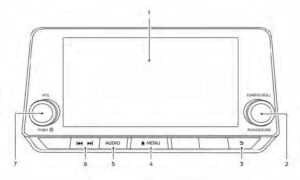
FM/AM RADIO
- Display screen
- PUSH SOUND button / TUNE·SCROLL knob
- BACK button
- MENU button
- AUDIO button
- (SEEK/TRACK) buttons
- VOL (volume) knob / PUSH (power) button
Audio main operation
VOL (volume) knob / PUSH (power) button Place the ignition switch in the ON position and press the PUSH (power) button while the system is off to call up the mode (radio, AUX, Bluetooth® audio, USB or iPod®) that was playing immediately before the system was turned off. To turn the system off, press the PUSH (power) button. Turn the VOL (volume) knob to adjust the volume. This vehicle may be equipped with Speed Sensitive Volume. When this feature is active, the audio volume changes as the driving speed changes.
MENU button
Press the MENU button to show the Menu screen. Touch the “Settings” key on the display, then touch the “Sound” key.
| Sound Settings | ||
| Bass | Adjusts the bass to the desired level. | |
| Treble | Adjusts the treble to the desired level. | |
| Balance | Adjusts the balance to the desired level. Balance adjusts the sound level between the left and right speakers. | |
| Fade | Adjusts the fade to the desired level. The fade adjusts the sound level between the front and rear speakers. | |
| Speed Sensitive Volume | Adjusts the speed-sensitive volume function, which increases the volume of the audio system as the speed of the vehicle increases. Set to “OFF” to disable the feature. The higher the setting, the more the volume increases in relation to vehicle speed. | |
Audio button
Press to display the audio screen. When this button is pressed while the audio screen is not displayed, the last audio source played will play.

AM/FM radio screen
- “AM Menu” / “FM Menu” key
Touch to display the radio menu screen. - “Direct Tune” (if so equipped)
Touch to manually enter a station. - Audio source indicator
Indicates the currently selected audio source. - Reception information display Reception information currently available such as frequency, station name, etc. is displayed.
- Preset list
To listen to a preset station, touch the corresponding station from the preset list. If displayed, touch the “ <” or“>” keys to scroll the preset list.
AM radio operation
Press the MENU button and touch the “AM” key or press the AUDIO button and select AM on the bottom of the Launch Bar to bring up the AM display screen. If another audio source is playing when the “AM” key is pressed, the audio source playing will automatically be turned off and the last radio station played will begin playing.
AM Menu
Touch the “AM Menu” key to display the AM Menu screen options:
- SCAN: To scan the stations, touch the “AM Menu” key on the radio screen and then touch the “SCAN” key. The stations will be tuned from low to high frequencies and stop at each broadcasting station for several seconds. Touching the “SCAN” key again during this period of several seconds will stop tuning and the radio will remain tuned to that station.
- Refresh: Touch the “Refresh” key to scan and update the station list displayed on the right side of the AM Menu screen.
(SEEK/TRACK) buttons
Press the or buttons to tune from low to high or high to low frequencies and to stop at the next broadcasting station.
1 to 6 Station memory operations
Up to six stations can be registered in the preset list.
- Select the AM radio band.
- Tune to the station you wish to store.
- Touch and hold one of the preset numbers in the preset list.
- The information such as frequency will be displayed on the preset list. To select and listen to the preset stations, push on the steering wheel briefly or touch a preferred station on the preset list on the radio screen.
FM radio operation
Press the MENU button and touch the “FM Menu” key or press the AUDIO button and select FM on the bottom of the Launch Bar to bring up the FM display screen. If another audio source is playing when the “FM” key is pressed, the audio source playing will automatically be turned off and the last radio station played will begin playing. The FM stereo indicator (STEREO) is shown on the screen during FM stereo reception. When the stereo broadcast signal is weak, the radio automatically changes from stereo to monaural reception.
FM Menu
Touch the “FM” Menu key to display the FM Menu screen options:
- SCAN: To scan and tune the stations, touch the “FM Menu” key on the radio screen and then touch the “SCAN” key. The stations will be tuned from low to high frequencies and stop at each broadcasting stations for several seconds. Touching the “SCAN” key again during this period of several seconds will stop tuning and the radio will remain tuned to that station. Refresh: Touch the “Refresh” key to update the station list displayed on the right side of the FM Menu screen. RDS Info: Radio station and song information can be displayed on the FM display screen.
(SEEK/TRACK) buttons
Press the or buttons to tune from low to high or high to low frequencies and to stop at the next broadcasting station. 1 to 12 Station memory operations Up to 12 stations can be registered in the preset list.
- Select the FM radio band.
- Tune to the station you wish to store.
- Touch and hold one of the preset numbers in the preset list.
The information such as frequency will be displayed on the preset list. To select and listen to the preset stations, push on the steering wheel briefly or touch a preferred station on the preset list on the radio screen.
Auxiliary (AUX) device operation
Connecting auxiliary devices
Connect an AUX device to the AUX input jack located on the center console below the heater and air conditioner controls. The AUX input jack accepts any standard analog audio input such as from a portable cassette player, CD player, MP3 player or phone. Insert a 1/8 in (3.5 mm) stereo mini plug in the audio input jack. If a cable with a mono plug is used, the audio output may not function normally.
Activation and playing
Turn on the AUX device. Connect an AUX cable to the AUX device and the AUX input jack. Select AUX mode from the audio source menu screen or by pressing the Source button on the steering wheel.

AUX screen
- Audio source indicator
This indicates that the AUX source is currently playing. - “Volume Setting” keys
Touch one of the keys to select the sound output gain from Low, Medium, and High. - AUX from Launch Bar
Touch to change from another source to AUX.
Additional features
For additional information, in this section regarding the USB connection port available with this system. in this section regarding the iPod® player available with this system. in this section about the Bluetooth® audio interface available with this system. Microsoft (WMA) Obligation of
Labeling
Additional Obligation of Labeling This product is protected by certain intellectual property rights of Microsoft Corporation and third parties. Use or distribution of such technology outside of this product is prohibited without a license from Microsoft or an authorized Microsoft subsidiary and third parties.

USB (Universal Serial Bus) CONNECTION PORT Connecting a device to the USB Connection Port
WARNING
Do not connect, disconnect, or operate the USB device while driving. Doing so can be a distraction. If distracted you could lose control of your vehicle and cause an accident or serious injury.
CAUTION
To avoid damage and loss of function when using a USB device, note the following precautions. Do not force the USB device into the USB port. Inserting the USB device tilted or upside-down into the port may damage the port. Make sure that the USB device is connected correctly to the USB port. Do not grab the USB port cover (if so equipped) when pulling the USB device out of the port. This could damage the port and the cover. Do not leave the USB cable in a place where it can be pulled unintentionally. Pulling the cable may damage the port. For additional information, refer to your device manufacturer’s owner’s information regarding the proper use and care of the device. The USB port is located beneath the heater and air conditioner controls. Insert the USB device into the connection port. When a compatible storage device is plugged into the connection port, compatible audio files on the storage device can be played through the vehicle’s audio system.
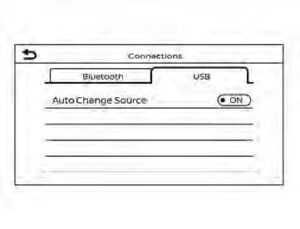
USB connections screen
Press the MENU button and touch the “Connections” key or press the “Settings” key and touch the “Connections” key to change USB settings.
- Auto Change Source
Touch “ON” or “OFF” to change the audio source settings for USB memory devices or iPod® connected through a USB cable.
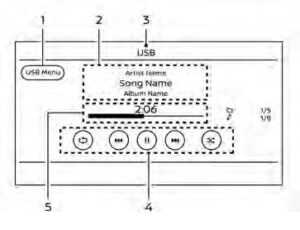
USB screen
- “USB Menu” key
- Touch to switch to the USB Menu screen. Track information
Track information such as the song name, artist name, and album name are displayed. - Audio source indicator
Indicates the currently selected audio source. - USB operation keys
Touch to control USB playback functions - Playtime and progress bar
The play time of the track is displayed. The bar indicates the progress in playing a track.
USB operation keys
Touch to control USB playback functions.
| Keys | Description |
| Each time the “ ” key is touched, the repeat mode changes. | |
|
|
Touch to return to the beginning of the current track. Touch again to select the previous track. Touch and hold to rewind the current track. |
| Touch to play the track. | |
| Touch to pause the track. | |
| Touch to select the next track. Touch and hold to fast-forward the track. | |
| Each time the “ ” key is touched, the random mode changes. |
USB memory device player operation
Activation and playing
Connecting the USB memory device to the port will start playing the USB memory. The USB memory device can also be played by touching the “USB” key on the Menu screen or by touching the USB on the Launch Bar. To pause playing the USB memory device touch the “ ” key. To resume playing, touch the “ ”key. Skipping tracks To skip the tracks, press the or buttons on the control panel or touch the “ ”or“ ” keys on the screen repeatedly until the preferred track is selected.
NOTE:
Depending on the condition, skipping to the previous track may require pressing the button or touching the key twice. Pressing the button or touching the key once may only restart the current track from the beginning.
Fast-forwarding/rewinding
To rewind or fast-forward the track, press and hold the or buttons on the control panel or touch and hold the “ ” or “ ” keys on the screen.
Changing play mode Repeat mode
Touch the “ ” key on the USB screen to change the repeat mode.
The following modes are available:
All: Repeat all
1 Folder: Repeat folder/sub-folder 1 Track: Repeat track
Random mode
Touch the “ ” key on the screen to change the random mode as follows: No text displayed: Random off All: Repeat all 1 Folder: Repeat folder/sub-folder
USB menu
Touch the “USB Menu” key on the USB screen to display the USB Menu screen.
| “Now Playing” key | Touch to display the USB screen. |
| “Folder List” key | Touch to display the folder list. Touch an item on the list to select the folder. The sub- folder or track list will be dis- played. Select a sub-folder or track from the list. |
| “Album Artwork” | Touch to run on/off the album artwork display on the USB screen. |
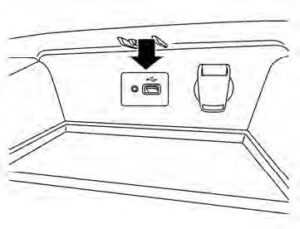
iPod®* PLAYER OPERATION Connecting iPod®
WARNING
Do not connect, disconnect, or operate the USB device while driving. Doing so can be a distraction. If distracted you could lose control of your vehicle and cause an accident or serious injury.
CAUTION
Do not force the USB device into the USB port. Inserting the USB device tilted or upside-down into the port may damage the port. Make sure that the USB device is connected correctly into the USB port. Do not grab the USB port cover (if so equipped) when pulling the USB device out of the port. This could damage the port and the cover. Do not leave the USB cable in a place where it can be pulled unintentionally. Pulling the cable may damage the port. For additional information, refer to your device manufacturer’s owner’s information regarding the proper use and care of the device. To connect an iPod® to the vehicle so that the iPod® can be controlled with the audio system controls and display screen, use the USB connection port located beneath the heater and air conditioner controls. Connect the iPod®-specific end of the cable to the iPod® and the USB end of the cable to the USB connection port on the vehicle. If your iPod® supports charging via a USB connection, its battery will be charged while connected to the vehicle with the ignition switch in the ON position. While connected to the vehicle, the iPod® can only be operated by the vehicle audio controls. To disconnect the iPod® from the vehicle, remove the USB end of the cable from the USB connection port on the vehicle, then remove the cable from the iPod®. * iPod® is a trademark of Apple Inc., registered in the U.S. and other countries.
Compatibility
The following models are compatible:
- iPod® Classic 5th generation (firmware version 1.3.0 or later)
- iPod® Classic 6th generation (firmware version 2.0.1 or later)
- iPod® Classic 7th generation (firmware version 2.0.4 or later)
- iPod® Touch 2nd generation (firmware version 4.2.1 or later)*
- iPod® Touch 3rd generation (firmware version 5.1 or later)
- iPod® Touch 4th generation (firmware version 5.1 or later)
- iPod® nano – 1st generation (firmware version 1.3.1 or later)
- iPod® nano – 2nd generation (firmware version 1.1.3 or later)
- iPod® nano – 3rd generation (firmware version 1.1.3 or later)
- iPod® nano – 4th generation (firmware version 1.0.4 or later)
- iPod® nano – 5th generation (firmware version 1.0.2 or later)
- iPod® nano – 6th generation (firmware version 1.1 or later)
- iPhone® 3G (firmware version 4.2.1 or later)
- iPhone® 3GS (firmware version 5.1 or later)
- iPhone® 4 (firmware version 5.1 or later)
- iPhone® 4S (firmware version 5.1 or later)
- Some features of this iPod® may not be fully functional.
Make sure that your iPod® firmware is updated to the version indicated above.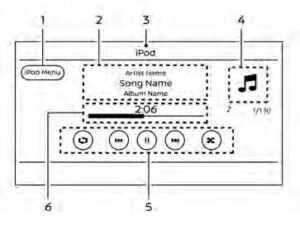
iPod screen
- “iPod Menu” key
Touch to switch to the iPod Menu screen. - Track information
Track information such as the song name, artist name, and album name are displayed. - Audio source indicator
Indicates the currently selected audio source. - Album artwork
An image of the album artwork is displayed when available if the setting is turned on. - iPod® operation keys
Touch to control iPod® playback functions - Playtime and progress bar
The play time of the track is displayed. The bar indicates the progress in playing a track.
iPod® operation keys
Touch to control iPod® playback functions.
| Keys | Description |
| Each time “ ” key is touched, the repeat mode changes. | |
| Touch to return to the begin- ning of the current track. Touch again to select the previous track. Touch and hold to rewind the current track. |
|
| Touch to play the track. | |
| Touch to pause the track. | |
| Touch to select the next track. Touch and hold to fast-forward the track. | |
| Each time “ ” key is touched, the random mode changes. |
iPod® memory device player operation
Activation and playing
Connecting the iPod® to the vehicle via a USB cable will activate the iPod® mode. The iPod® can also be played by touching the “iPod” key on the Menu screen or by touching the iPod on the Launch Bar.
Skipping tracks
To skip the tracks, press the or buttons on the control panel or touch the “ ”or“ ” keys on the screen repeatedly until the preferred track is selected.
NOTE:
Depending on the condition, skipping to the previous track may require pressing the button or touching the key twice. Pressing the button or touching the key once may only restart the current track from the beginning.
Fast-forwarding/rewinding
To rewind or fast-forward the track, press and hold the or buttons on the control panel or touch and hold the “ ” or “ ” keys on the screen,
Changing play mode Repeat mode
Touch the “ ” key on the iPod® screen to change the repeat mode. The following modes are available.
- No text displayed: Repeat off
- All: Repeat all
- One: Repeat track
Random mode
Touch the “ ” key on the screen to change the random mode as follows. ” is not highlighted: Random off ” highlighted: Random on
iPod® Menu
Touch the “iPod Menu” key on the iPod® screen to display the iPod® Menu screen.
| “Now Playing” key | Touch to display the USB screen. |
| “Folder List” key (if so equipped) | Touch to display the folder list. Touch an item on the list to select the folder. The sub- folder or track list will be dis- played. Select a sub-folder or track from the list. |
| “Album Artwork” key | Touch to run on/off the album artwork display on the USB screen. |
| “Playlists” key | Touch to display the list ac- cording to the selected item. |
| “Artists” key | |
| “Albums” key | |
| “Songs” key | |
| “Podcasts” key | |
| “Genres” key | |
| “Composers” key | |
| “Audiobooks” key | |
| “iTunes Radio” key |
BLUETOOTH® STREAMING AUDIO
If you have a compatible Bluetooth® audio device that is capable of playing audio files, the device can be connected to the vehicle’s audio system so that the audio files on the device play through the vehicle’s speakers.
NOTE:
For additional information, refer to the cellular phone owner’s manual.

NOTE:
The connecting procedure must be performed when the vehicle is stationary. If the vehicle starts moving during the procedure, the procedure will be canceled.
Manual Connecting Procedure
- Press the MENU button on the control panel.
- Touch the “Connections” key on the screen.
- In the Bluetooth tab, touch the “Add New” key to connect a phone.
- When a compatible phone is found a message with a PIN appears on the screen.
Verify the PIN is correct and accept the connection.
| Menu Item | Result | |
| Bluetooth | Allows users to switch Bluetooth® on and off. Bluetooth® must be turned on in order to connect a device. | |
| ON | Turns Bluetooth® functionality on. To turn it off, touch the “ON” key again. The indicator light will go off. | |
| Favorite (Connection first) | Allows users to toggle “Phone” and “Audio” favorite settings on and off. | |
| PIN | Allows users to customize the PIN to a four-digit number. | |
Automatic Connecting Procedure
If no phone is connected to the system, press and hold the button on the steering wheel for less than 1.5 seconds. After the prompt, speak “Add Phone”, the system will announce “transferring to the add phone settings menu”. The system will start the pairing procedure. When a compatible phone is found, a message with a PIN appears on the screen. Operate the Bluetooth® phone to complete the connection process.
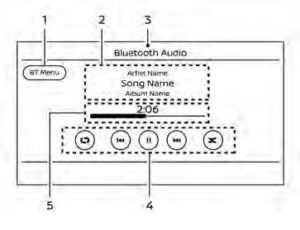
Bluetooth® screen
- “BT Menu” key
Depending on the Bluetooth® version supported by the connected device, either the “BT Menu” key or the “Connections” key is displayed. - Track information
Track information such as the song name, artist name, and album name are displayed. - Audio source indicator
Indicates the currently selected audio source. - Bluetooth® audio operation keys Touch to control Bluetooth® audio play-back functions
- Playtime and progress bar
The play time of the track is displayed. The bar indicates the progress in playing a track.
Bluetooth® operation keys
Touch to control Bluetooth® playback functions.
| Keys | Description |
| Each time the “ ” key is touched, the repeat mode changes. | |
| Touch to return to the beginning of the current track. Touch again to select the previous track. Touch and hold to rewind the current track. |
|
| Touch to play the track. | |
| Touch to pause the track. | |
| Touch to select the next track. Touch and hold to fast-forward the track. | |
| Each time the “ ” key is touched, the random mode changes. |
Bluetooth® audio operation
The ability to pause, change tracks, fast forward, rewind, randomize, and repeat music may be different between devices. Some or all of these functions may not be supported on each device.
NOTE:
Depending on the Bluetooth® audio device that is connected, it may not be possible to perform audio operations or a delay may occur before music is played back.
Activation and playing
A Bluetooth® audio device can be played by touching the “Bluetooth” key on the Menu screen or by touching Bluetooth on the Launch Bar. To pause playing the Bluetooth® audio, touch the “ ” key. Touch the “ ”key to resume playing.
Changing folders
To change folders, touch the “BT Menu” key.
Fast-forwarding/rewinding
To fast-forward or rewind the track, press and hold the buttons on the control panel or touch the “ ”or“ ” keys on the screen.
Changing play mode
Repeat mode
Touch the “ ” key on the screen to change the repeat mode.
Random mode
Touch the “ ” key on the screen to change the random mode.
NOTE:
Available repeat/random modes change depending on the connected device.
BT Menu
Touch the “BT Menu” key on the Bluetooth® audio screen to display the Bluetooth® audio menu screen. The following items are available.
| “Now Playing” key | Touch to display the Bluetooth® audio screen. |
| “Current List” key (if so equipped)* | A list of tracks in the currently selected folder is displayed. |
| “Connections” key | Touch to display the connections screen. |
| “Folder List” key* | Touch to display the folder list. Touch an item on the list to select the folder. |
*: displayed only when available.
NOTE:
Depending on the connected device, the “BT Menu” key may not be displayed.

STEERING WHEEL SWITCH FOR AUDIO CONTROL
- Menu control switch/ OK button
- (back) switch
- (SEEK/TRACK) buttons
- Volume control switch
Volume control switch
Push the volume control switch up or down to increase or decrease the volume.
Menu control switch/OK button
In the vehicle information display, navigate to “Audio”. Use the OK button to change the mode in the following sequence: AM → FM → USB/iPod®*→ Bluetooth® Au-dio* → AUX* → AM. * These modes are only available when compatible media storage is inserted into the device or connected to the system.
SEEK/TRACK buttons
For most audio sources, pushing the tuning switches for more than 1.5 seconds provides a different function than pushing for less than 1.5 seconds.
AM and FM:
Press the or buttons for less than 1.5 seconds to increase or decrease the preset station. Press the or buttons for more than 1.5 seconds to seek up or down to the next station.
iPod®:
Press the or buttons for less than 1.5 seconds to increase or decrease the track number.
USB:
Press the or buttons for less than 1.5 seconds to increase or decrease the track number. Press the or buttons for more than 1.5 seconds to reverse or fast forward the current song.
Bluetooth® Audio:
Press the or buttons for less than 1.5 seconds to skip ahead or back to the next song. Press the or buttons for more than 1.5 seconds to reverse or fast forward the current song.
(back) switch
Push the (back) switch to return to the previous screen or cancel the current selection.
ANTENNA
The antenna pattern is printed inside the rear window.
CAUTION
Do not place metalized film near the rear window glass or attach any metal parts to it. This may cause poor reception or noise When cleaning the inside of the rear window, be careful not to scratch or damage the rear window antenna. Lightly wipe along the antenna with a dampened soft cloth.
FAQ
The 2022 Altima typically supports various audio sources, including AM/FM radio, CDs, Bluetooth, USB drives, and smartphone integration.
You can typically turn the audio system on or off using the power button located on the head unit or infotainment system.
The volume control allows you to adjust the audio system’s sound level. Turn the knob clockwise to increase the volume and counterclockwise to decrease it.
You can select the audio source (e.g., radio, CD player, Bluetooth, USB) by pressing the source or mode button on the head unit or touchscreen.
Use the tuning knob or seek buttons to manually tune to a station or seek to the next available station with a strong signal.
Yes, you can typically set presets by pressing and holding a numbered preset button to save the current station and press it again to recall the preset.
The Altima’s audio system usually offers equalizer settings for adjusting bass, treble, balance, fade, and more.
To pair your smartphone, access the Bluetooth menu, enable Bluetooth on your phone, and follow the on-screen instructions for pairing.
Yes, many Altima models support voice commands for controlling audio playback and making hands-free calls.
Connect a USB drive to the USB port, and the system should recognize and play compatible audio files.
Some Altima models come equipped with a CD player. To use it, load CDs into the player and use the playback controls on the head unit or steering wheel.
Yes, when your phone is connected via Bluetooth, you can make and receive calls, access contacts, and use voice commands for phone functions.
Smartphone integration platforms like Apple CarPlay and Android Auto are often available, allowing you to access your phone’s music, apps, and navigation through the infotainment system.
Yes, you can usually find sound settings to fine-tune the audio experience, including adjusting balance, fade, and soundstage settings.
Yes, you can typically mute the audio quickly by pressing the mute button, often found on the head unit or steering wheel.
Useful Link
View Full User Guide: Nissan ALTIMA 2022 User Guide
Download Manuals: https://www.nissanusa.com/owners/ownership/manuals-guides.html
2023 Nissan Altima Specs, Price, Features and Mileage (Brochure)


